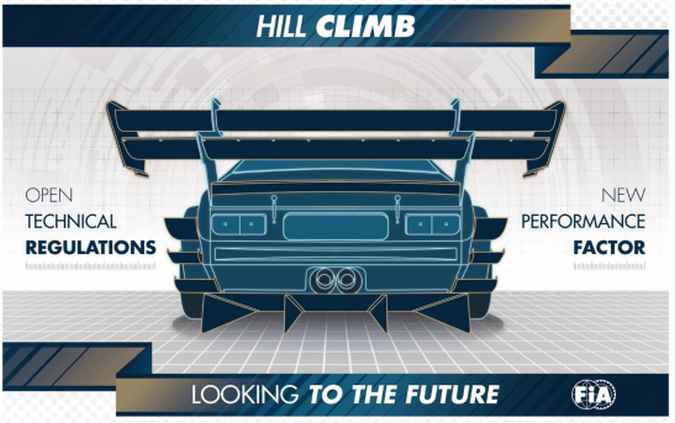TOWARDS NEW TECHNICAL REGULATIONS FOR HILL CLIMB

An ambitious reform of the classification of hill climb cars, based on the Pf (“Performance Factor”) concept will be trialled by the FIA during the 2018 season.
In all modesty, hill climb is one of the rare motor sport specialisations that can still boast of being widely accessible. Take for example, the average level of participation in competitions: it is not unusual to count more than 150 competitors, or even 200 cars, at the start line of the same event. The magic of the discipline continues to enchant; for drivers the challenge is short but intense and demanding, and for the public, the spectacle is unique for its setting, but also for the variety of cars competing. Hill climb is not hindered by the standardisation of cars you see in so many other disciplines.
That said, its strength can also sometimes be its weakness. The diversity of cars that compete in hill climb makes the regulations very (or even excessively) complex for the people involved, whether they are drivers, organisers, scrutineers, media or spectators. For the latter, understanding the competition and its classifications is very difficult.
On the one hand, the hill climb championships that are based exclusively on the homologation regime (N, A, R, GT, etc.) such as the FIA European Championship, are starting to suffer from a major lack of eligible cars, because the manufacturers are currently rarely homologating their models in the FIA groups. On the other hand, the unilateral openness to the greatest number of cars by each ASN and each organiser, which is certainly a guarantee of greater participation, has an almost anarchic effect.
Because of this, some events combine several competitions – for example, all of the events of the European Championship are associated with one or several national or regional championships – and each one of these competitions has its own results. The same car can find itself in different categories and classes according to the championship in which it is participating!
A NECESSARY REFORM
To address this situation, the FIA Hill Climb Commission, with the support of the Technical Department, has undertaken an in-depth review, with the main objective being the development of regulations that are as inclusive and as practical as possible. This is how the “Performance Factor” project was born – “Pf” for short. The founding principle: to design a shared technical framework enabling the inclusion of a maximum number of cars. With the exception of hybrid and electric cars, all cars with a combustion engine of less than 6,500 cc are permitted, as long as they conform to minimum safety standards as defined by the current FIA Appendix J. This is the case whether the cars are homologated or not, for cars whose homologation has expired, cars from single-make trophies or (inter)national series, including those which were constructed short of, or modified beyond, the current standards of these championships or series, etc. The origin of the car or its level of preparation or modification do not matter. The Pf concept is intentionally accessible. It also aims to be practical and easy to measure: indeed, under Pf, cars are simply classified according to a “weight/performance factors” ratio, in which the performance factors are easily measurable physical criteria, structured around five elements: weight, engine, aerodynamics, transmission and chassis structure.
In practice, each competitor will be asked to input into a mathematical formula around thirty values taken from his car. He will be asked to do so, free of charge, via an online application (which will be available as a mobile application in the future). The mathematical formula will thus calculate a number corresponding to the Performance Factor, or the “Pf”, of the car. This Pf value will determine the class in which the car will have to compete. It will be recorded in a database, accessible to the drivers, organisers and scrutineers. If, between two races, the driver makes any modification or change to his car, he will simply have to update the technical datasheet for his car in the database.
The classification of cars in hill climb will thus be greatly facilitated and simplified: instead of being spread among 15, 20 or 25 groups and classes, as is the case today, the cars will be grouped into five or six classes according to their Pf value and without the current ambiguities. As well as lightening the workload for the scrutineers, the regulatory freedom that accompanies the Pf concept sits perfectly with the prevailing spirit of hill climbing, where the drivers and teams also like to express their ingenuity and their originality in the preparation of the cars.
The strength of the Pf concept is that it can facilitate a genuinely innovative technical approach and give a new lease of life to hill climbing, without excluding any of the current cars. On the contrary, it could even widen the field of eligible cars within a single competition, thanks to a unique technical framework, which could potentially become universal if all of the ASNs choose to adopt it.
In 2018, the concept will begin a trial phase within the framework of the European Championship, with the establishment of virtual classifications using the Pf classification during the three FIA events. For all the other competitions of the season, the FIA officials will be present to inform the organisers and local scrutineers. They will also invite drivers to declare the technical characteristics of their car in order to get to know the Pf concept, and to anticipate the effective transition to this new classification system, which, it is hoped, will be in place for the 2019 edition of the European Hill Climb Championship.
At this stage, the application of the concept is aimed at so-called closed cars – touring cars, GT and silhouette-cars – but in the future, it should be possible to study and implement a similar methodology for single-seaters and two-seater prototypes.
Link to Pf web page: www.fia.com/pf








